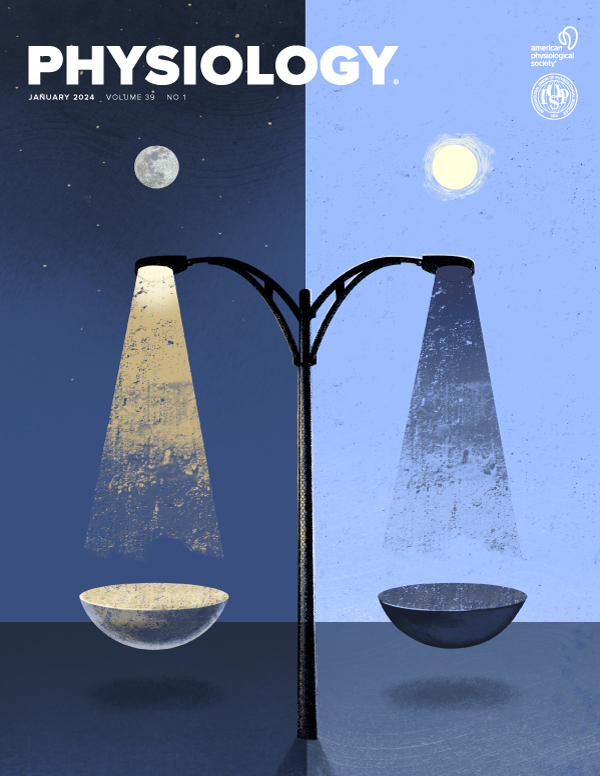被动热疗法可改善健康中老年人的认知和脑血管功能
IF 5.3
2区 医学
Q1 PHYSIOLOGY
引用次数: 0
摘要
流体认知功能(阿尔茨海默病中受损最严重的认知领域)随着年龄的增长而下降,使老年人易患阿尔茨海默病和相关的痴呆症。与年龄相关的脑血管功能障碍会损害脑血流,从而导致慢性脑灌注不足,这与认知障碍有关。氧化应激的增加和由此导致的一氧化氮(NO)生物利用度的丧失可能在与年龄相关的脑血管功能障碍中发挥机制作用。被动热疗法(即定期热暴露)改善外周血管结局,减少氧化应激,因此也可能改善认知和脑血管功能。目的:验证热疗可改善体液认知功能、增加脑总血流量(tCBF)、减少脑血管活性氧(ROS)产生和提高NO生物利用度的假说。方法和结果:中年和老年(ML/O)成年人(50岁以上)随机分为8-10周被动热疗法(通过热[40°C]水浸泡;30 x 60分钟的疗程)或假对照(通过热中性[36°C]水浸泡;NCT03264508)。在热疗或假干预的基线(前)和结束(后)收集以下初步结果(n=6-10/组)。使用NIH工具箱认知电池评估的流体认知综合评分,在接受热疗法的受试者中,从基线时的97±3(平均±SEM)增加到干预结束时的100±3 (p=0.03),在所有美国成年人中从第42百分位到第50百分位有所改善,但在假手术受试者中没有一致的变化(p=0.16)。通过椎动脉和颈内动脉的双工超声评估,tCBF从基线时的766±99 mL/min增加到热疗后的841±123 mL/min (p=0.03),而假手术后没有变化(术前:723±20 vs后:729±26 mL/min;p = 0.89)。以人脑内皮细胞(HBECs;技术重复n=24-29),高温(39℃)培养;以匹配热疗过程中的体内核心温度)和标准(37°C)条件。在高温条件下培养的HBECs的基础ROS产量较低(高温条件:860±7 AU比标准条件:907±5 AU;p<0.01)和更高的乙酰胆碱刺激NO生成(热:1.5±0.06比标准:1.3±0.04倍的NO生成变化;p = 0.03)。结论:这些结果表明,热疗可以改善ML/O成人的液体认知和脑血流量,可能是通过减少脑内皮细胞ROS的产生和增加NO的生物利用度来实现的。热疗法显示出在受阿尔茨海默病影响最大的领域保护认知能力和改善ML/O成人脑血管功能的潜力。Nih / ncats ul1 tr002535;T32 AG000279;这是在2023年美国生理学峰会会议上发表的完整摘要,仅以HTML格式提供。此摘要没有附加版本或附加内容。生理学没有参与同行评议过程。本文章由计算机程序翻译,如有差异,请以英文原文为准。
Passive heat therapy improves cognitive and cerebrovascular function in healthy midlife and older adults
Fluid cognitive function (the domain of cognition most impaired in Alzheimer’s Disease) declines with aging, predisposing older adults to Alzheimer’s Disease and related dementias. Age-related cerebrovascular dysfunction contributes to cognitive decline by impairing brain blood flow such that there is chronic cerebral hypoperfusion, which has been linked to cognitive impairment. Increased oxidative stress and the resultant loss of nitric oxide (NO) bioavailability likely play mechanistic roles in age-related cerebrovascular dysfunction. Passive heat therapy (i.e., regular heat exposure) improves peripheral vascular outcomes and reduces oxidative stress and, therefore, may also improve cognitive and cerebrovascular function. Purpose: To test the hypotheses that heat therapy would 1) improve fluid cognitive function, 2) increase total cerebral blood flow (tCBF), and 3) reduce cerebrovascular reactive oxygen species (ROS) production and increase NO bioavailability. Methods and results: Midlife and older (ML/O) adults (50+ years) were randomized to 8-10 weeks of passive heat therapy (via hot [40 °C] water immersion; 30 x 60-min sessions) or sham control (via thermoneutral [36 °C] water immersion; NCT03264508). The following preliminary results were collected at baseline (pre) and at the end (post) of the heat therapy or sham intervention (n=6-10/group). Fluid Cognition Composite scores, assessed using the NIH Toolbox Cognition Battery, increased from 97± 3 (mean ± SEM) at baseline to 100± 3 at end-intervention (p=0.03) in subjects who underwent heat therapy, an improvement from the 42nd to 50th percentile of all U.S. adults, but there was no consistent change in sham subjects (p=0.16). tCBF, assessed via duplex ultrasonography of the vertebral and internal carotid arteries, increased from 766± 99 mL/min at baseline to 841± 123 mL/min after heat therapy (p=0.03), whereas there was no change following sham (pre: 723± 20 vs. post: 729± 26 mL/min; p=0.89). Cerebrovascular ROS production and NO bioavailability were assessed with fluorescent probes in vitro using human brain endothelial cells (HBECs; technical replicates n=24-29) cultured in hot (39 °C; to match in vivo body core temperature during heat therapy sessions) and standard (37 °C) conditions. HBECs cultured in hot conditions had lower basal ROS production (hot: 860± 7 AU vs. standard: 907± 5 AU; p<0.01) and higher acetylcholine-stimulated NO production (hot: 1.5± 0.06 vs. standard: 1.3± 0.04 fold change in NO production; p=0.03). Conclusions: These results suggest that heat therapy can improve fluid cognition and brain blood flow in ML/O adults, possibly by reducing brain endothelial cell ROS production and increasing NO bioavailability. Heat therapy shows potential to protect cognitive performance in the domain most affected by Alzheimer’s Disease and improve cerebrovascular function in ML/O adults. NIH/NCATS UL1 TR002535; T32 AG000279; R01 AG073117 This is the full abstract presented at the American Physiology Summit 2023 meeting and is only available in HTML format. There are no additional versions or additional content available for this abstract. Physiology was not involved in the peer review process.
求助全文
通过发布文献求助,成功后即可免费获取论文全文。
去求助
来源期刊

Physiology
医学-生理学
CiteScore
14.50
自引率
0.00%
发文量
37
期刊介绍:
Physiology journal features meticulously crafted review articles penned by esteemed leaders in their respective fields. These articles undergo rigorous peer review and showcase the forefront of cutting-edge advances across various domains of physiology. Our Editorial Board, comprised of distinguished leaders in the broad spectrum of physiology, convenes annually to deliberate and recommend pioneering topics for review articles, as well as select the most suitable scientists to author these articles. Join us in exploring the forefront of physiological research and innovation.
 求助内容:
求助内容: 应助结果提醒方式:
应助结果提醒方式:


